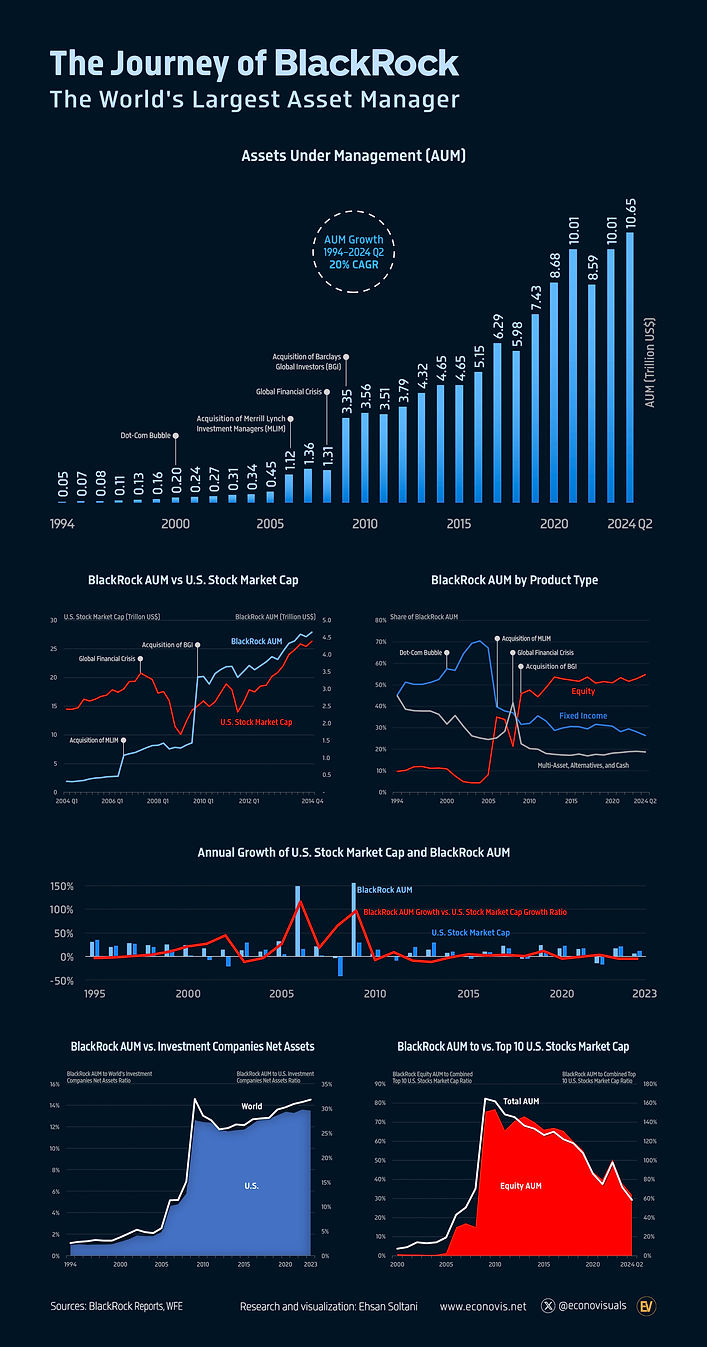The Rise of BlackRock: The World's Largest Asset Manager
Econovis Team
A Journey from $53 Billion in 1994 to $10,646 Billion in June 2024, Achieving a 20% Annual Growth Rate (CAGR)
BlackRock, Inc., founded in 1988, has emerged as the world's largest asset manager. Its growth reflects strategic foresight, innovation, and adaptability in the financial landscape. From $53 billion in assets in 1994, BlackRock's assets under management (AUM) surged to $10,646 billion by June 2024, achieving a compounded annual growth rate (CAGR) of 20%.
BlackRock's ascent from a startup to a market leader was fueled by client and employee attraction and strategic acquisitions. Established to provide institutional clients with research-intensive asset management coupled with advanced risk management techniques, BlackRock's emphasis on risk management became central to its strategy, attracting diverse clients and investment mandates.

Historical Phases of BlackRock
1. Rapid Growth as a Startup (1988–2005)
Founded in 1988 as Blackstone Financial Management in New York, BlackRock rebranded in 1992. The firm merged with PNC in 1995 and went public in 1999, providing the capital necessary for expansion and product enhancement. AUM soared from $52.7 billion in 1994 to $452.7 billion in 2005, with an annual growth rate of 21.6% (CAGR), significantly outpacing industry and U.S. stock market growth. Despite the Dot-com Bubble's impact, which saw a 27% decrease in U.S. stock market capitalization, BlackRock's AUM rose by 33%, driven largely by fixed-income assets constituting 57% of its AUM by 2000, contrasting with an 11% equity share.
2. Strategic acquisitions (2006–2009)
The acquisition of Merrill Lynch Investment Managers (MLIM) in 2006 doubled BlackRock's AUM and expanded its global footprint. The acquisition of Barclays Global Investors (BGI) in 2009, including its successful iShares ETF business, solidified BlackRock's ETF market leadership. AUM surged 156% from $1.31 trillion in 2008 to $3.35 trillion in 2009. Due to these two major acquisitions, BlackRock's AUM surged rapidly, achieving an annual growth rate of 65% (CAGR) from 2006 to 2009. During the 2008 financial crisis, while U.S. stock market capitalization halved, BlackRock's AUM grew by 4.3%. Fixed-income dominance declined post-MLIM and BGI acquisitions, from 66.3% in Q2 2006 to 31.5% in Q4 2009, with equity rising from 8.8% to 45.9%.
3. Maturation as Global Market Leader (2010–2024)
Following its ascent to global leadership, BlackRock achieved an 8.3% CAGR from 2009 to Q2 2024, aligning with industry and U.S. stock market capitalization growth. Notably, the top 10 U.S. stocks grew at a 16.3% CAGR. By Q2 2024, equity and fixed income constituted 55% and 26% of AUM, respectively, while multi-asset, alternatives, and cash management totaled 19%. Cash management's share decreased from 45% in 1994 to 7.3% from 2010 to 2024, with multi-asset and alternatives comprising 8.7% and 2.8% by Q2 2024.
BlackRock's approach to the Dot-com Bubble, Financial Crisis 2008, and subsequent periods underscores its conservative investment stance, prioritizing sustained growth over higher-yield, higher-risk opportunities.
Strategic Approaches
1. Innovation and Technological Advancement: BlackRock's ongoing investment in technology, exemplified by the Aladdin platform, underscores its commitment to competitive edge through advanced risk management and investment capabilities.
2. Expansion into New Markets: Strategic entry into emerging markets such as Asia-Pacific, Latin America, and the Middle East has diversified BlackRock's client base and enhanced capital access.
3. Focus on Sustainable Investing: Responding to demand, BlackRock integrates ESG criteria into investment processes, launching ESG-focused funds to support clients in navigating the shift towards a low-carbon economy.
4. Resilience in Challenging Times: BlackRock's robust risk management and diversified product offerings have enabled it to navigate economic downturns and market volatility, reinforcing its position as a resilient market leader.
Conclusion
BlackRock's journey from a modest startup to the world's largest asset manager is a testament to its strategic foresight, innovation, and adaptability. Through calculated risk management, strategic acquisitions, and a focus on sustainable investing, BlackRock has not only weathered economic storms but also set benchmarks in the asset management industry. As BlackRock continues to expand and innovate, it remains a pivotal force in the global financial landscape, demonstrating that with the right strategy and vision, sustained growth and resilience are achievable.
